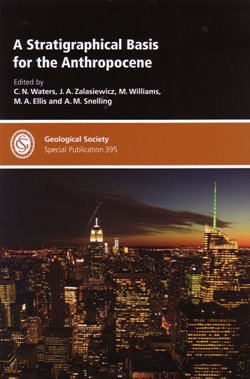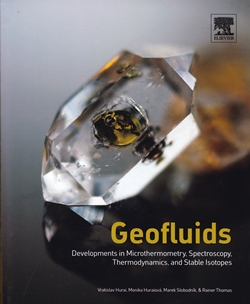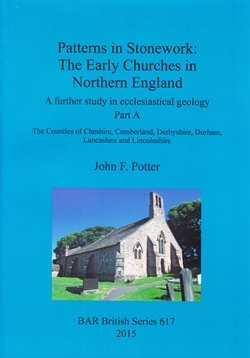
A Stratigraphical Basis for the Anthropocene
There is little doubt that human activity has drastically changed the face of the Earth, and this has led to the suggestion that we are now living in a new geological epoch - the Anthropocene.
The Holocene was a time of gradual increase of humans and human influence, and the Anthropocene began with level of geologically-significant global change.
Anthropogenic changes to the lithosphere, biosphere, chemosphere, (and now 'technosphere') have overtaken the geological agents with which most of us are familiar. Humans have now overtaken nature as producers of minerals and sediments, outpacing sediment routing systems. Extinction is usually the result of competition and evolution, not overfishing; and artificial radionuclides obscure the classic volcanics for dating recent deposits.
With this new era of significant processes there is a need to move from an informal chronological concept to formally-defined stratigraphic unit, the Anthropocene, which needs a definition based on markers. This volume compiles evidence from a wide range of disciplines to help constrain the Anthropocene. In doing so it ambles deftly from formal stratigraphic definitions and discussion through to a wide range of indicators of anthropological activity which may be used to define the epoch.
In addition to discussing the familiar indicators of stratigraphic definition (ice, volcanic markers, geomagnetics, index fossils), the editors have given space to uniquely Anthropocene considerations from archaeology to anthropogenic radionuclides. The chapter 'Coral reefs in the Anthropocene' makes for a frank (albeit grim) assessment of reef decline but doesn’t necessarily contribute to the book’s overall objective of considering the stratigraphical basis for the epoch. However, the excellent speleology chapter 'Anthropocene viewed from the underworld' is a holistic appreciation of multiple markers and their interrelations.
Overall, the publication treats Anthropocene stratigraphy as more of a journey than a destination. Much discussion is given to marker methodology, but the basis for some of these markers for stratigraphy is often condensed into a few final paragraphs rather than being considered as an integral part. The reader is given substantial and fascinating instruction on decay of isotopes from nuclear weapons testing, but is left with more questions than answers about how to use these as a basis for stratigraphy. This is a shame, given the volume’s ambitious title. Given that the authors are such proponents of the Anthropocene (albeit with sensible caution) it is a shame the volume doesn’t quite 'go the final mile', from detailing the controversies and methodologies to suggesting their more concrete application to formal stratigraphy.
Reviewed by Nathan Allen
A STRAPHIGRAPHICAL BASIS FOR THE ANTHROPOCENE by C N WATERS, J A ZALASIEWICZ, M WILLIAMS, M A ELLIS & A M SNELLING 2014. GSL Special Publication #395; 321pp, hbk; ISBN 9781862396289. Geological Society Bookshop.

The Climates of the Geological Past
All geologists will have heard of Alfred Wegener. Few will have heard of his father-in-law, Wladimir Köppen, one of the founders of modern climatology. In his early work Wegener applied the principle of the primacy of climatic zones to reconstruct continental positions through time, capitalizing in a way on Lyell’s notion that a shifting of the continents across climate zones might explain the global distribution of fossils and the location of past climate-sensitive deposits. Meeting Köppen, whose climate classification system matches temperature and precipitation to patterns of vegetation and soils, Wegener found an ideal collaborator.
Their magnum opus was published in German in 1924. It featured the first comprehensive suite of global palaeoclimatic maps (displaying the distributions of climate sensitive indicators) for the Carboniferous, Permian, Triassic, Jurassic, Cretaceous, Eocene, Miocene, and Pliocene + Early Quaternary, all made without the benefit of palaeomagnetic observations. Salt and gypsum deposits were found to be common where such evaporites are found today, in the arid belts north and south of the equator. Cretaceous corals characterized the equatorial zone between the 30th parallels, just like today. Glacial indicators clustered around the poles. And coals occurred under temperate humid conditions, and in the humid tropics.
For their Quaternary chapter, Köppen invited a contribution from Milutin Milankovitch, who had just begun using celestial mechanics to explain climate change over the past 65,000 years. Milankovitch graciously allowed the use of his published calculations in the book, and added some new unpublished features. As the book’s editors point out, this made it possible for the first time “to establish a precisely defined time scale of Late Cenozoic glacial-interglacial history”.
Where Köppen and Wegener went wrong was in thinking that differences in the positions of the fronts of past ice sheets in Europe might also reflect the wandering of the Quaternary pole, whose positions would not be established for another 25 years. Even so, they did make clear that the peak of the last Ice Age - the Last Glacial Maximum – occurred about 20,000 years ago. Köppen, the great climatologist, convinced Milankovitch that the key to creating a glaciation was the duration of summer warmth, not winter cold. Milankovitch’s data showed that the latest peak in insolation and summer warmth occurred about 10,000 years ago. Since then, Köppen reasoned, orbital change cooled northern hemisphere summers – a process that is still going on today.
Despite the limitations, this is a historical masterpiece and well worth the purchase.
Reviewed by Colin Summerhayes
THE CLIMATES OF THE GEOLOGICAL PAST / DIE KLIMATE DER GEOLOGISCHEN VORZEIT by KÖPPEN, W, AND WEGENER, A, Borntraeger Science Publishers, Stuttgart 2015, edited by J Thiede, K Lochte and A Dummermuth. ISBN 978-3-443-01088-1.W: www.borntraeger-cramer.com/9783443010881

Geofluids
The interdisciplinary nature of research undertaken to understand the role of fluids in geological environments, coupled with rapid developments in new non-destructive analytical techniques, has meant that the production of a single current and practical reference or data source on geofluids / palaeofluids has proved problematic – a situation familiar in other burgeoning areas of geoscience. ‘Geofluids’ is a commendable attempt to address this shortcoming in the literature.
Introduced with overview chapters summarising the general characteristics of geofluids, their phase diagrams and equations of state, the main sections (with supporting appendices) cover both direct (fluid inclusion microthermometry, Raman and infrared spectroscopy) and indirect (fluid thermodynamics and stable isotopes) techniques that are currently applied to routinely analyse and interpret geological problems. An additional chapter on miscellaneous spectrographic and chromatographic methods is also included.
Topics are presented through a practical step-by-step approach, describing the theoretical background of each method, sample preparation, measurements, analysis and the interpretation of data appropriate to mineral – fluid – melt equilibria. Most chapters include relevant worked examples derived from both theory and a range of specific case studies, many in the form of solved ‘Problem Boxes’ within the main text.
The appendices contain extensive equations of state data, stable isotope fractionation equations and Raman spectroscopic analysis tables (including Raman analytical data for 548 mineral phases and fluid species arranged by both vibrational energies and phase/species name) that underpin the identification of fluid inclusion daughter minerals and associated dissolved compounds.
The volume provides an excellent synthesis of current geofluid research methodologies and their application. Authored by a team of highly experienced researchers in the field, the book is written in a clear and concise style, with numerous figures, data-tables, graphical drawings and photographs that appropriately supplement the accompanying text. Many are presented in colour and enhance the understanding of the textual details.
The expected readership are graduate students and professional academic and industrial geoscience researchers specialising in fluids and fluid flow in the Earth’s crust and mantle, fluid–rock interactions, hydrothermal geochemistry and mineral, oil and gas exploration. An overdue treatment of the subject, this book is recommended and will, I expect, become established as a standard reference work.
Reviewed by Mark Griffin
GEOFLUIDS – DEVELOPMENTS IN MICROTHERMOMETRY, SPECTROSCOPY, THERMODYNAMICS AND STABLE ISOTOPES by VRATISLAV HURAI, MONIKA HURAIOVÁ, MAREK SLOBODNÍK AND RAINER THOMAS. Published by: Elsevier. 2015. ISBN 978-0-12-803241-1. Sbk. 489pp. List Price: £100.00, www.store/elsevier.com.

Patterns in Stonework: the Early Churches in Northern England
In his recent book The Road to Little Dribbling, author Bill Bryson remarks: “If you tried to visit all the mediaeval churches in England – just England – at the rate of one a week, it would take you 308 years”. The indefatigable John Potter, in his continuing quest to prove Mr Bryson wrong, has now followed his surveys of the churches of Ireland, and of Early Welsh Churches (2013, reviewed 2014) with this survey of England’s northern counties. This is part A – Part B, covering Northumberland, Nottinghamshire, Staffordshire, Westmorland and Yorkshire, is expected in 2016.
Once again, Potter uses his geologist’s eyes to help archaeologists (whose lithological observations are generally spurious) recognise ‘Anglo Saxon’ (pre-Romanesque) building work where no classically recognised architectural details survive, using such features as ‘patterned’ use of stone (alternating ‘long and short’ work in the quoins) as touchstone.
Identifying lithologies in early churches is no simple matter even for an experienced geologist like Potter. In Wales, he found himself faced with its less-than-forthcoming Palaeozoic limestones and greywackes, rendered (pun intended) even more intractable by the lamentable local habit, encouraged by CADW, of limewashing. Here, he faced a different problem.
Lower Cretaceous rocks of Lincolnshire are poorly exposed and difficult to identify. In church walls (sampling, of course, not permitted!) and in their weathered state, they are virtually impossible to name accurately. This problem is not unique to this region, where Lower Cretaceous – Jurassic ironstones can hardly be distinguished without fossils. Middle Jurassic oolites of the ‘stone belt’ pose similar problems. Potter asks – could there be a case for professional geologists being allowed to sample? Perhaps minor chips, following a formal application? He suspects (with good reason) that the answer would probably be no.
The hundreds of churches surveyed are illustrated in crisp B&W photos within the text, accompanied by perceptive descriptions of their stonework. Potter draws attention to the fact that Cheshire and Lancashire, with negligible ‘Anglo Saxon’ remains, contrast markedly with the riches of Durham and Lincolnshire. He suggests that while this may reflect contemporary population size, it may also be a function of the availability of good stone. Local rock types in Cheshire and Lancashire are inappropriate for building and not durable; early churches, if they existed, would almost certainly have been completely rebuilt later.
Potter’s survey endorses the existence of distinctive ‘patterned’ stonework seen elsewhere in pre-Norman building, while Norman and later churches display changes in building fashion similar to those noted in his previous studies. At £55, this volume represents excellent value and can be highly recommended to serious amateurs of ecclesiastical architecture everywhere.
Reviewed by Ted Nield
PATTERNS IN STONEWORK: THE EARLY CHURCHES IN NORTHERN ENGLAND – A FURTHER STUDY IN ECCLESIASTICAL GEOLOGY PART A: THE COUNTIES OF CHESHIRE, CUMBERLAND, DERBYSHIRE, DURHAM, LANCASHIRE AND LINCOLNSHIRE by JOHN F POTTER 2015 BAR British Series 617 ISBN 978 1 4073 1393 1 W: www.barpublishing.com 314pp List Price: £55.00